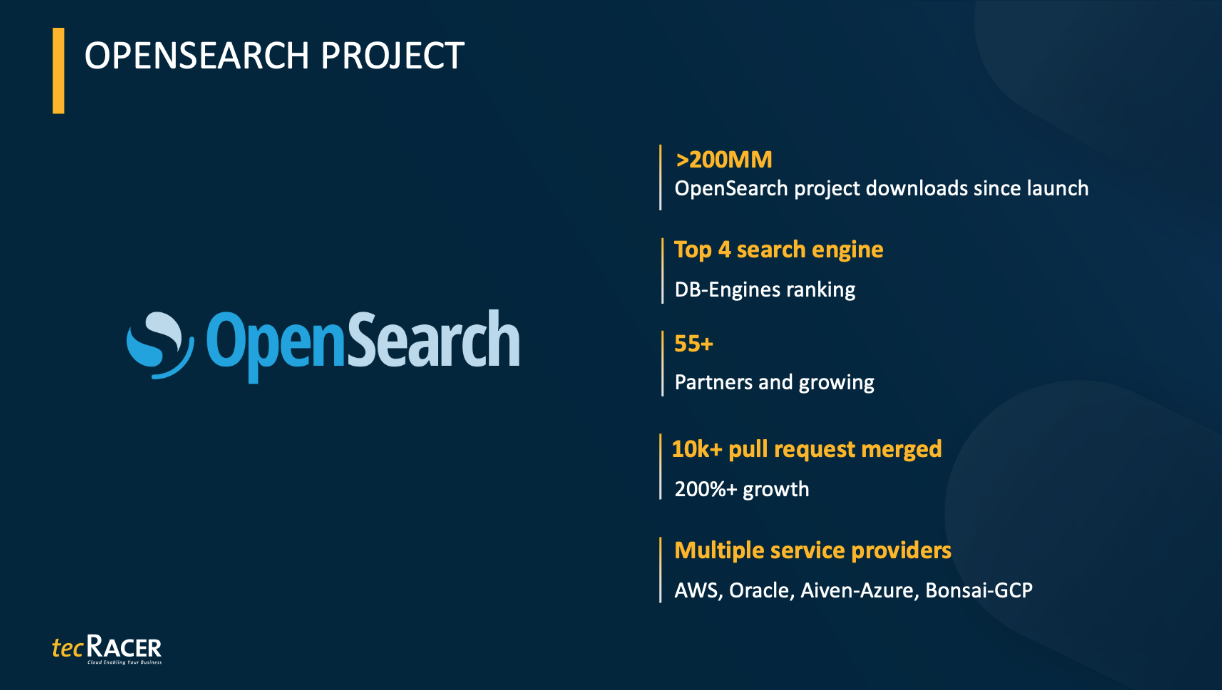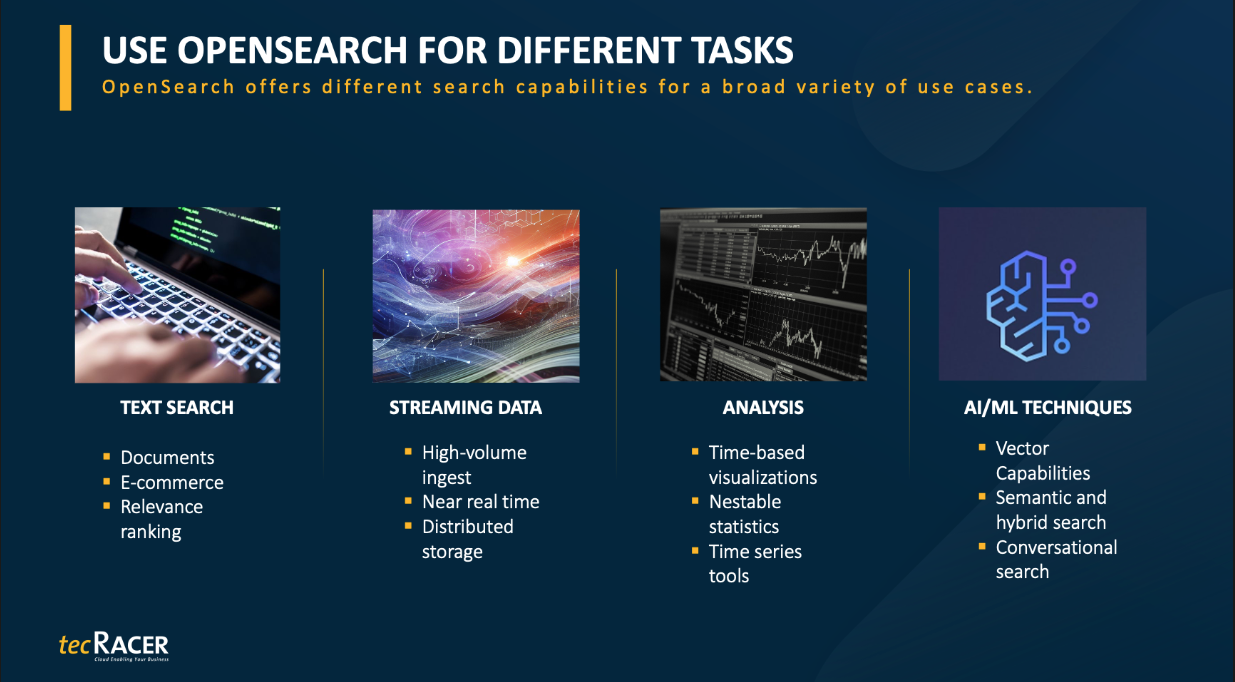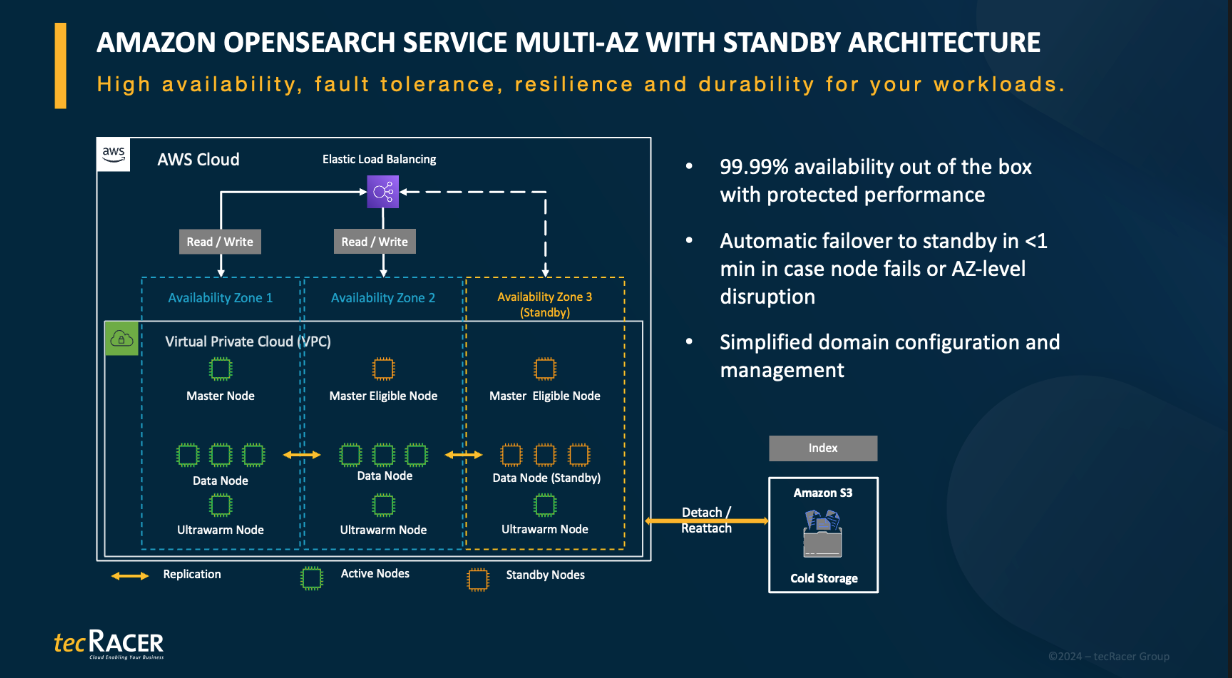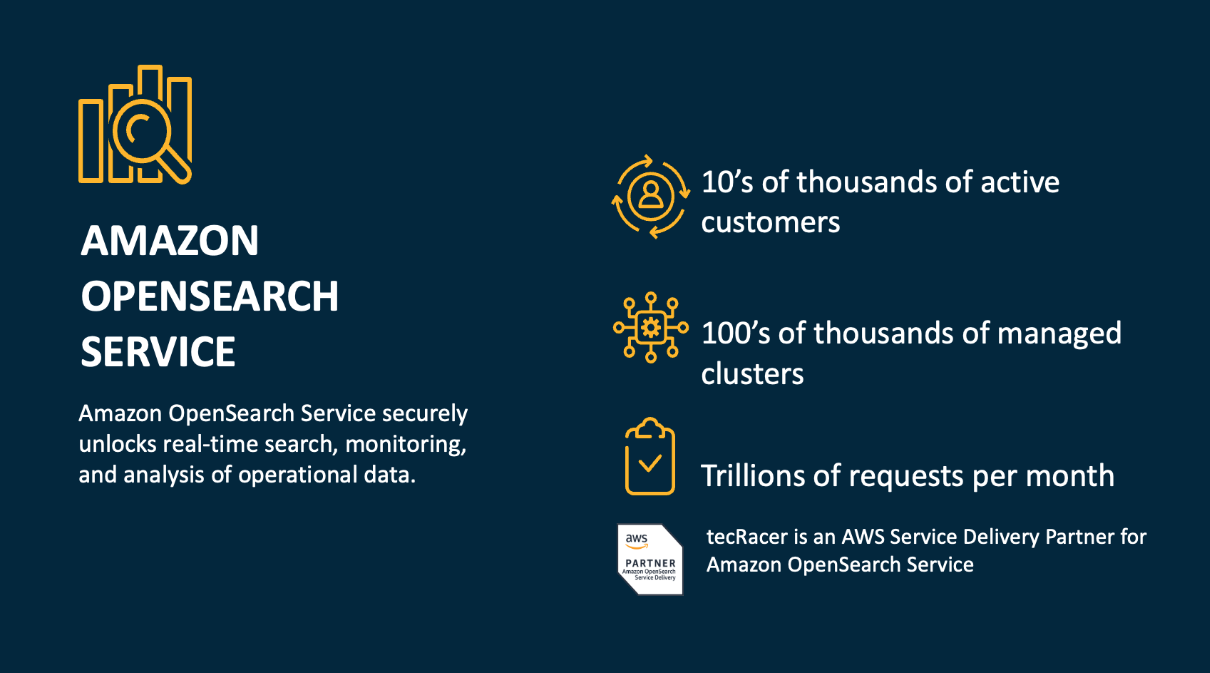OpenSearch vs. Elasticsearch: Why OpenSearch is the Better Choice for AWS Users in 2024
In the dynamic landscape of search and analytics engines, AWS users often find themselves weighing the merits of OpenSearch against Elasticsearch. While both platforms offer robust search capabilities, Amazon OpenSearch Service emerges as the superior option for those operating within the AWS ecosystem. This comprehensive analysis delves into the reasons why OpenSearch stands out and how it compares to Elasticsearch, particularly for AWS users.
Historical Context
Elasticsearch Background
Elasticsearch was first released in 2010 by Shay Banon as an open-source, distributed search and analytics engine built on top of Apache Lucene. It quickly gained popularity due to its powerful full-text search capabilities, scalability, and ease of use. Elasticsearch became the core component of the Elastic Stack (formerly known as the ELK Stack), which includes Logstash for data processing and Kibana for data visualization.
AWS’s Adoption and Forking of OpenSearch
Amazon Web Services (AWS) began offering Elasticsearch as a managed service in 2015, providing users with a scalable and fully managed Elasticsearch experience on the AWS cloud. However, in 2021, Elastic NV, the company behind Elasticsearch, changed the licensing of Elasticsearch and Kibana from the open-source Apache License 2.0 to the Server Side Public License (SSPL) and the Elastic License, which are not considered open-source licenses by the Open Source Initiative.
In response to these licensing changes, AWS announced the creation of OpenSearch, a community-driven, open-source fork of Elasticsearch and Kibana under the Apache License 2.0. OpenSearch aims to continue the development of an open-source search and analytics suite that is fully compatible with the open-source versions of Elasticsearch and Kibana.

The Emergence of Amazon OpenSearch Service
Following the introduction of OpenSearch, AWS rebranded its managed Elasticsearch service as Amazon OpenSearch Service. This service supports both OpenSearch and legacy Elasticsearch versions up to 7.10, which was the last version released under the Apache 2.0 license. The move ensured that AWS users could continue to benefit from an open-source solution without licensing restrictions, while also fostering a community around OpenSearch.
The Formation of the OpenSearch Project under the Linux Foundation
In September 2024, the Linux Foundation announced the establishment of the OpenSearch Project under its governance, creating the OpenSearch Software Foundation. This move was aimed at fostering open collaboration in search and analytics. By bringing OpenSearch into the Linux Foundation, the project benefits from a neutral home that encourages contribution and participation from a broad community of developers and organizations.
The OpenSearch Software Foundation’s goals include:
- Promoting open-source development in the search and analytics space.
- Ensuring a transparent governance model that encourages community input and collaboration.
- Facilitating the growth of the OpenSearch ecosystem through events, documentation, and outreach.
Community and Ecosystem Growth
Since its inception, OpenSearch has gained significant traction in the open-source community. AWS and other contributors have been actively developing new features, plugins, and enhancements, ensuring that OpenSearch remains a cutting-edge solution for search and analytics. The OpenSearch project has also emphasized transparency and community involvement, inviting developers to participate in its development process.
Key Advantages of Amazon OpenSearch Service
1. Seamless AWS Integration
Amazon OpenSearch Service is tailored specifically for the AWS environment, offering unparalleled integration:
- Native connectivity with essential AWS services such as Identity and Access Management (IAM) and CloudWatch.
- Streamlined management and monitoring capabilities through the AWS Console, Command Line Interface (CLI), and Software Development Kit (SDK), providing consistent control across all interfaces.
- Reduced complexity and improved operational efficiency compared to running Elasticsearch on AWS infrastructure.
 In contrast, using Elasticsearch on AWS involves either deploying via AWS Marketplace or using Elastic Cloud. The Marketplace option has known issues, including bugs and limited regional availability, as evidenced by customer reviews here. Elastic Cloud, while more reliable, results in separate billing and an external hosting setup, complicating integration with your AWS environment.
In contrast, using Elasticsearch on AWS involves either deploying via AWS Marketplace or using Elastic Cloud. The Marketplace option has known issues, including bugs and limited regional availability, as evidenced by customer reviews here. Elastic Cloud, while more reliable, results in separate billing and an external hosting setup, complicating integration with your AWS environment.
2. Open Source Flexibility and Cost Transparency
Backed by the OpenSearch Software Foundation, Amazon OpenSearch maintains its commitment to open-source principles:
- Enhanced customization and adaptability options, free from the constraints of vendor lock-in.
- Clear and predictable pricing, particularly beneficial for businesses looking to scale their operations.
- Open-source collaboration, allowing engineers and developers to innovate without proprietary licensing restrictions.
Elasticsearch, while also offering open-source versions, has proprietary features that can lead to vendor lock-in and less transparency in pricing.
3. Enterprise-Grade Security
OpenSearch’s tight integration with AWS security services ensures your data is protected, with simplified management and renewal processes enhancing security even further:
- Default security features integrated with AWS services like IAM and KMS.
- Private VPC deployment options and secure traffic routing via VPC endpoints ensure that traffic remains within AWS, adding another layer of security.
- Built-in encryption using AWS Key Management Service (KMS) ensures that all data, both at rest and in transit, is secure.
- ACM certificates for SSL/TLS encryption at the endpoint provide secure communication between clients and OpenSearch clusters, with automatic renewal processes simplifying certificate management.
Elasticsearch offers similar security features, but the seamless integration with AWS services in OpenSearch simplifies implementation and management.
4. High Availability at Lower Cost
Amazon OpenSearch Service is designed for high availability without incurring additional costs for cross-availability zone (AZ) data transfers:
- Cross-AZ data transfer is included at no extra charge.
- Cost-effective multi-AZ architectures, ensuring redundancy and fault tolerance.
- Automatic failover in case of node or AZ-level disruptions ensures minimal downtim
Elasticsearch on AWS may involve additional costs for cross-AZ data transfers and more complex configurations to achieve similar high availability.
5. Performance Optimizations
Amazon engineers are continually optimizing OpenSearch for better performance within AWS, integrating the latest innovations:
- Automatic fine-tuning based on workload patterns ensures optimal performance with minimal manual intervention.
- New Graviton and OR1 instances provide more cost-effective performance, reducing operational costs while maintaining high efficiency.
- Storing data on S3 enhances durability, offering better long-term data protection.
- Seamless scaling options allow OpenSearch to handle growing data volumes without compromising performance.
AWS’s ongoing improvements guarantee that both performance and features continue to evolve and improve over time.
While Elasticsearch also offers performance optimizations, OpenSearch’s deep integration with AWS infrastructure provides a more streamlined and efficient experience.

6. Enhanced Ingestion, Monitoring, Security, Visualization, and AI Integrations
Amazon OpenSearch Service offers a range of integrations to support various use cases, from data ingestion to advanced AI-driven workloads:
-
Ingestion Integrations: It simplifies the process of loading logs, traces, metrics, and configuration data through services like Amazon Kinesis Data Firehose, AWS Database Migration Service (DMS), Amazon CloudWatch Logs, and Amazon Managed Streaming for Apache Kafka. These integrations help ensure scalability as data volumes grow.
-
Monitoring Integrations: Built-in connections with AWS CloudWatch and AWS CloudTrail provide tools for monitoring clusters, detecting anomalies, and setting up alerts when necessary, making it easier to stay on top of your operations.
-
Security Integrations: OpenSearch integrates with AWS IAM, Cognito, SAML, and KMS to provide strong security controls and ensure data is protected both at rest and in transit. This includes advanced options for access management and encryption.
-
AI Integrations: For users looking to incorporate machine learning into their search workflows, OpenSearch integrates with Amazon Bedrock and SageMaker. These tools allow you to develop and deploy machine learning models directly into your OpenSearch environment, potentially improving search relevance or enabling predictive insights based on data patterns.
-
Vector Search Capabilities: OpenSearch also supports multidimensional vectors and integrates with FAISS (Facebook AI Similarity Search) for high-performance vector-based search. This can be useful for applications like recommendation systems, natural language search, or image similarity search, where more advanced search techniques are needed.
-
Visualization Integrations: OpenSearch Dashboards offer built-in visualization options, and there is also integration with Amazon Managed Grafana, allowing users to create detailed dashboards and reports from their data.

7. High Availability with Multi-AZ Architecture
Amazon OpenSearch Service offers a multi-AZ architecture that provides high availability and resilience:
-
Multi-AZ Failover: In the event of an Availability Zone failure, the service automatically fails over to a standby node within less than a minute, ensuring minimal disruption to your services. This feature works out of the box and requires little configuration.
-
99.99% Availability: OpenSearch ensures that your workloads are available 99.99% of the time, making it one of the most reliable options for critical applications.
-
Simplified Domain Management: With AWS managing the domain configuration, operational overhead is significantly reduced, allowing businesses to focus on their core operations instead of infrastructure management.
Considerations for Elasticsearch Users
While OpenSearch presents many advantages, there are situations where staying with Elasticsearch could be more practical:
- Significant investments in existing Elasticsearch infrastructure or reliance on specific Elasticsearch features.
- Complex, custom-built solutions tightly integrated with Elasticsearch, making migration difficult.
However, before deciding to stick with Elasticsearch, it’s worth running a proof-of-concept (PoC) with OpenSearch to evaluate its fit for your project.
Migration Considerations
For organizations considering a switch from Elasticsearch to OpenSearch:
- Conduct a thorough assessment of your current Elasticsearch implementation.
- Identify any integrations or features that may need adaptation.
- Plan a phased migration approach to minimize disruption.
- Leverage AWS migration tools and services to streamline the process.
- Consider engaging with AWS partners like tecRacer for expert guidance.

Conclusion
For businesses leveraging AWS, OpenSearch represents a forward-thinking choice that aligns perfectly with cloud-native architectures. Its deep AWS integration, transparent pricing, robust security, and operational benefits make it an ideal solution for both new projects and optimization of existing search infrastructures.
Even if you’re currently using Elasticsearch, exploring a migration to OpenSearch could unlock:
- Improved performance and scalability.
- Significant cost savings, especially for large-scale deployments.
- Enhanced security and compliance capabilities.
- Simplified operations and management within the AWS ecosystem.
To make an informed decision for your search and analytics infrastructure, consider conducting a proof of concept (PoC) with OpenSearch. Collaborate with AWS experts at tecRacer, a certified service delivery partner of Amazon OpenSearch, to guide you through the evaluation and migration process. Their expertise ensures you maximize the benefits of this powerful search and analytics platform, helping you achieve optimal performance and efficiency.
Links
- Linux Foundation Announces OpenSearch Software Foundation to Foster Open Collaboration in Search and Analytics
- Amazon OpenSearch Service Documentation
- OpenSearch Project on GitHub
- Elastic.Co
- ElasticSearch Reviews on the AWS Marketplace
- AWS Pricing Calculator for OpenSearch
- tecRacer - AWS Consulting Partner
